Bright And Sunny Lemon Lavender Cake Recipe
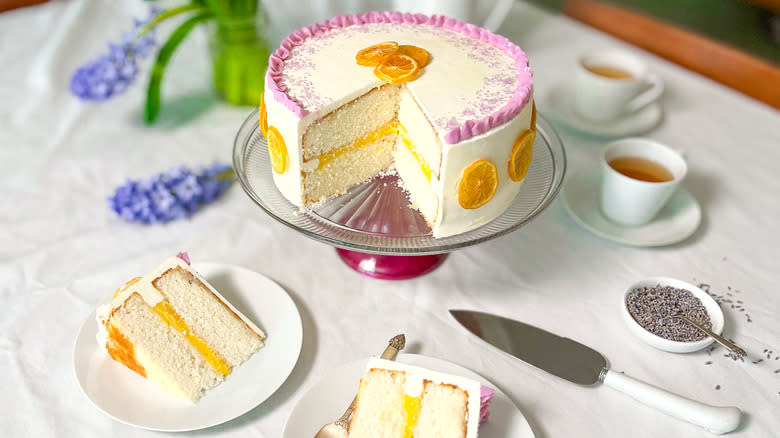
The aromas of lemon and lavender have a way of transporting you to a warm, sun-drenched spot. Not only do their scents pair beautifully together, but the bright citrus and sweet floral qualities of their flavors can combine to make for dreamy desserts, like this bright and sunny lemon lavender cake, which comes to us courtesy of recipe developer Julie Kinnaird. Kinnaird infuses delicate white chocolate-flavored cake layers by brushing them with a lavender simple syrup, then fills them with a tangy lemon curd. The cake is iced with a silky smooth Swiss meringue buttercream that has a touch of lavender extract. Candied lemon wheels add visual appeal and an additional zingy lemon garnish to nibble on. This cake is ideal for special occasions or simply to welcome spring and summer days ahead.
Although there are multiple steps involved in making the bright and sunny lemon lavender cake, if you can plan ahead it will help you to enjoy the process. The candied lemon wheels, lavender simple syrup, lemon curd filling, buttercream, and cake layers can all be made in advance to make assembling and decorating a breeze. The result is a show-stopping cake with a perfect harmony of flavors and textures.
Read more: 30 Types Of Cake, Explained
Gather The Bright And Sunny Lemon Lavender Cake Ingredients
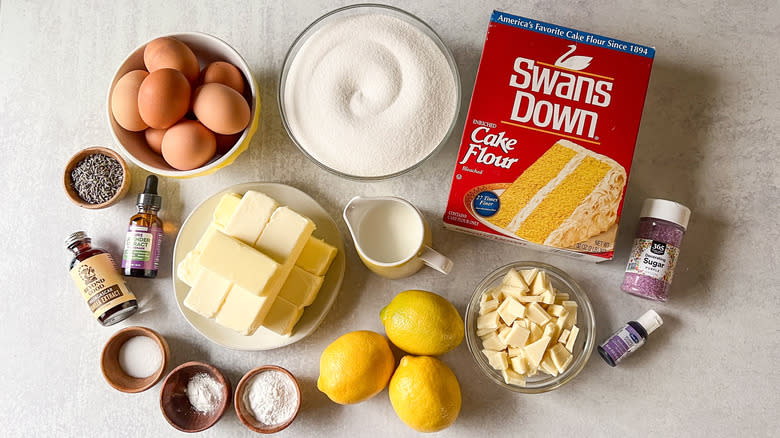
For this recipe, choose lemons that have fleshy bright yellow peels and feel ripe and juicy when squeezed. You will use the lemon juice and zest in the curd, as well as a whole lemon for the candied lemon wheels. You will need granulated sugar to make the candied lemon, the lavender simple syrup for soaking the cake layers, the lemon curd, the cake layers, and the Swiss meringue buttercream. Bleached cake flour is essential for achieving a delicate, tender crumb and true white chocolate adds a melt-in-your-mouth texture. We use baking powder and egg whites to leaven the cake layers, along with whole milk for moisture. You will need salt for the cake, lemon curd, and buttercream along with good-quality unsalted butter. Vanilla extract is used for baking the cake and for flavoring the buttercream. You will also want a bit of pure lavender extract to give the buttercream a boost. Dried culinary lavender is necessary for infusing the simple syrup (more on that below). Last, have fun with some lavender-colored sprinkles or paste food color for tinting your icing.
Step 1: Start Making The Candied Lemon
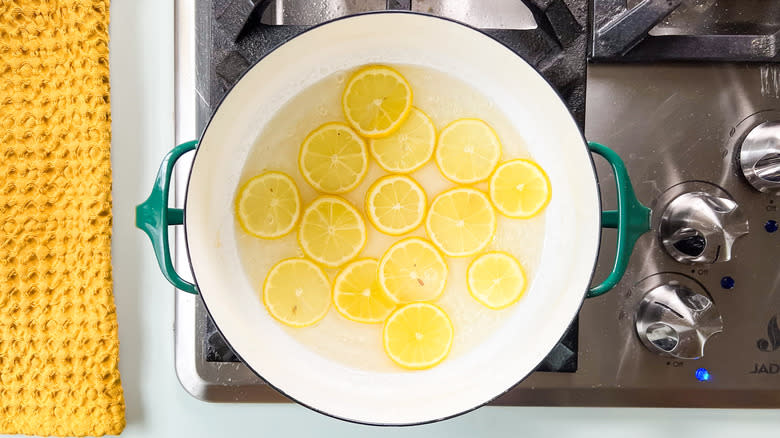
To make the candied lemon, combine the sugar, water, and lemon slices in a wide saucepan and bring to a boil.
Step 2: Simmer The Lemons
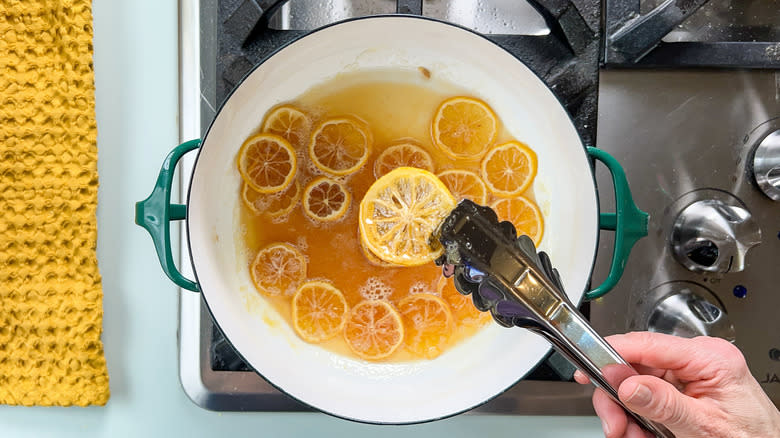
Reduce the heat to medium-low and simmer the lemon slices for 20 minutes or until the peels are translucent.
Step 3: Transfer The Lemon Wheels To A Rack
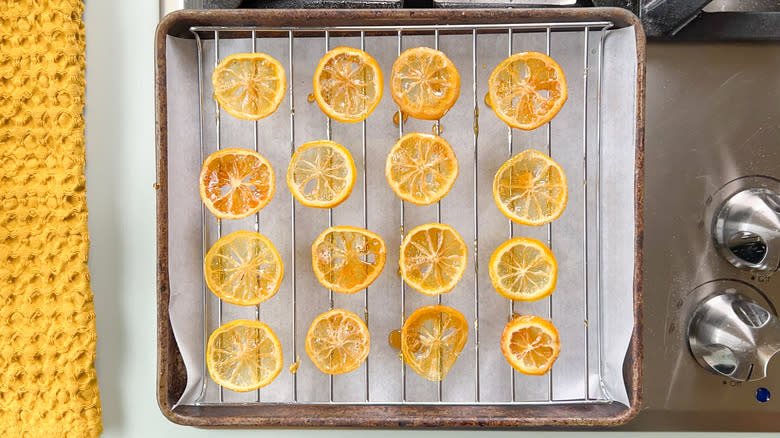
Transfer the slices to a rack to cool and allow to dry for at least 8 and up to 24 hours.
Step 4: Start Making The Lemon Curd
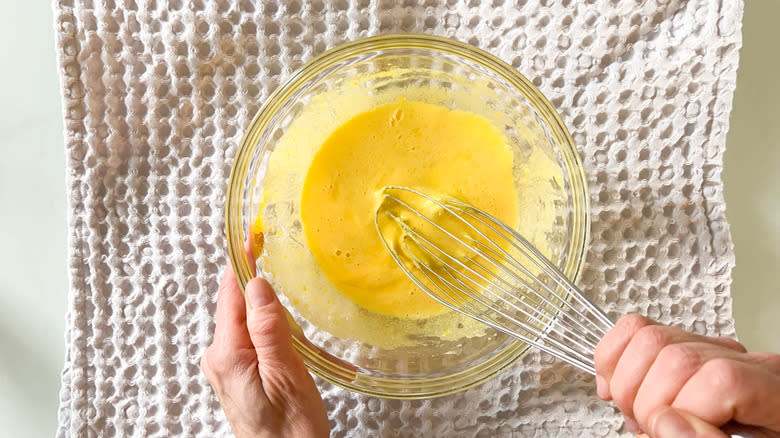
For the lemon curd, whisk together the yolks and sugar until pale yellow in a medium bowl.
Step 5: Combine The Lemon Juice And Butter In A Saucepan
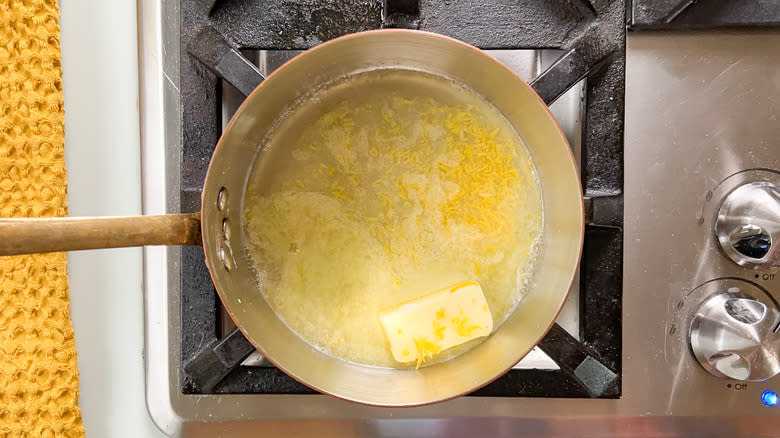
In a medium saucepan, combine the lemon juice, butter, salt, and zest, heating gently until the butter has melted.
Step 6: Temper The Egg Yolk Mixture
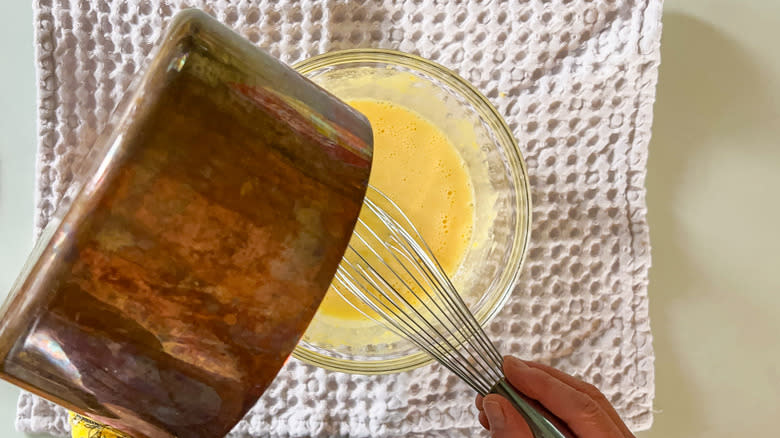
Temper the egg mixture by slowly drizzling in the warm butter mixture, whisking constantly.
Step 7: Cook The Lemon Curd
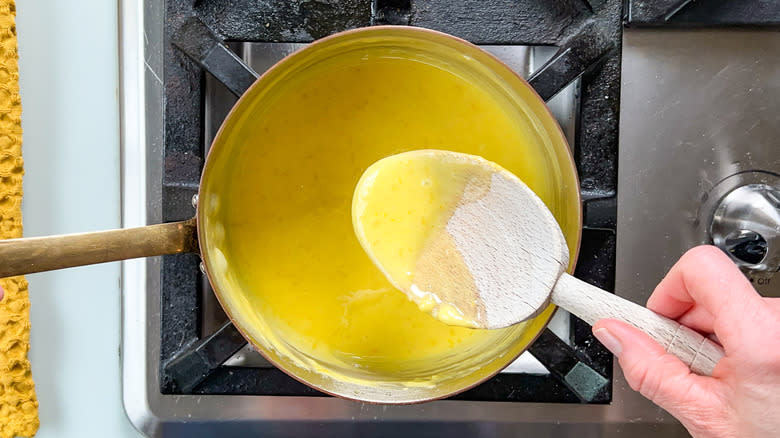
Transfer the curd base back to the saucepan and cook over medium-low heat, stirring constantly with a wooden spoon until thickened but not boiling.
Step 8: Strain The Curd
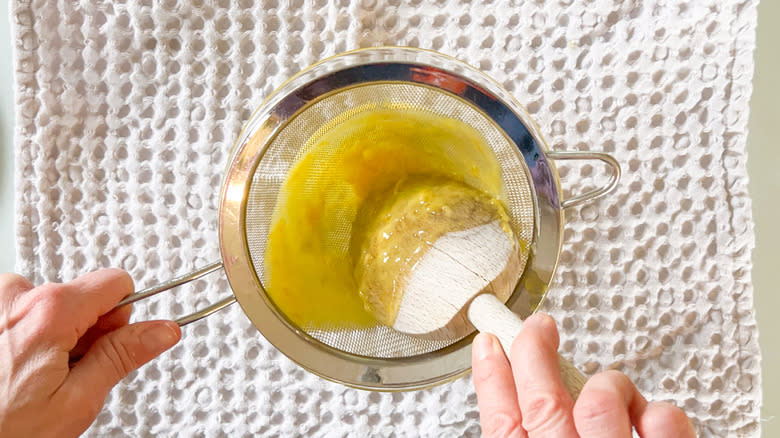
Strain the curd into a medium glass bowl.
Step 9: Chill The Curd
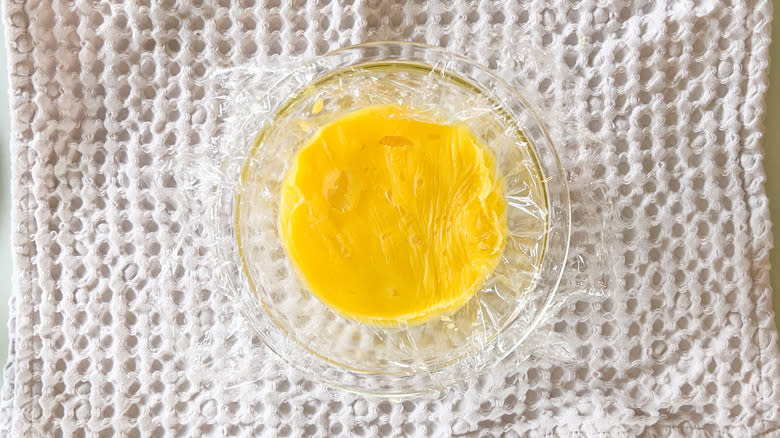
Cover the curd with plastic on the surface to prevent a skin from forming and place the bowl in the refrigerator to chill completely while baking the cakes (about 1 hour).
Step 10: Preheat The Oven
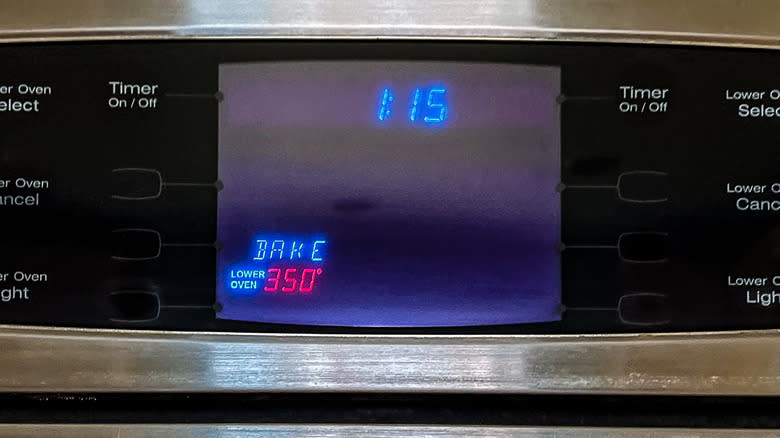
Preheat the oven to 350 F.
Step 11: Prepare The Cake Pans
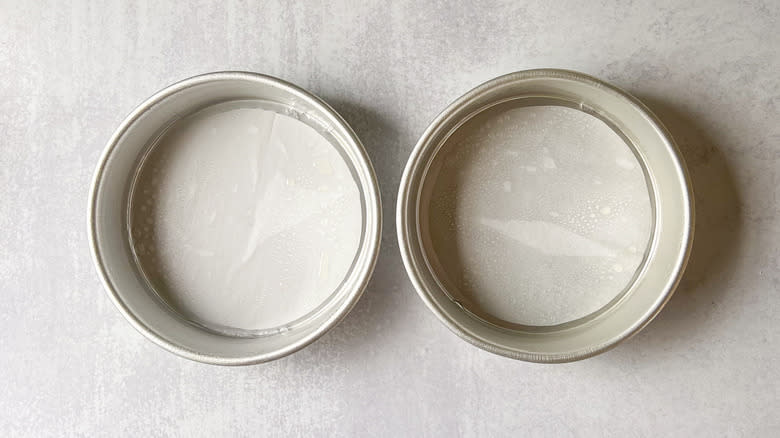
Grease and line the bottoms of two 9-inch round cake pans with parchment paper.
Step 12: Create A Double Boiler
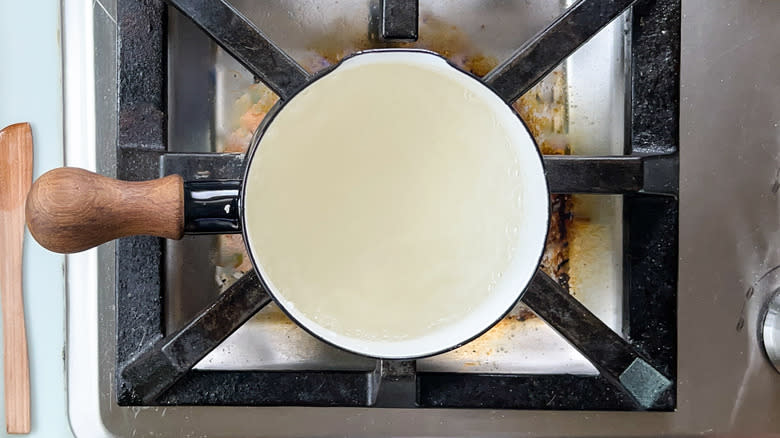
Create a double boiler by bringing an inch of water to a simmer in a saucepan.
Step 13: Melt The White Chocolate
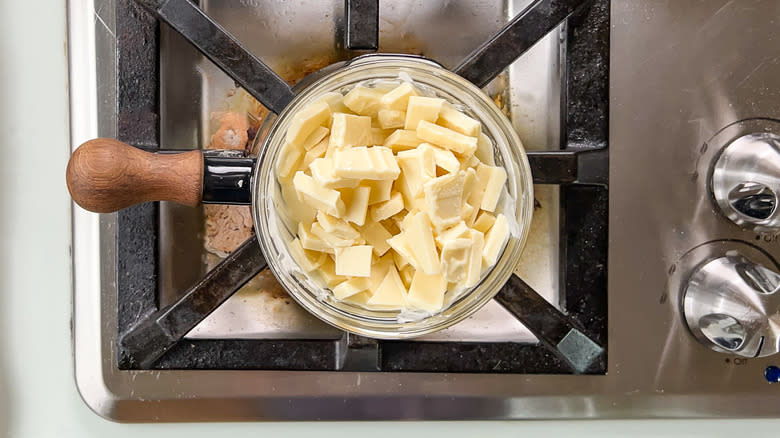
Turn off the heat and place the white chocolate in a heat-proof bowl over the pan, stirring frequently until the chocolate is melted. Remove the bowl and set aside.
Step 14: Whisk Together The Egg Whites And Vanilla
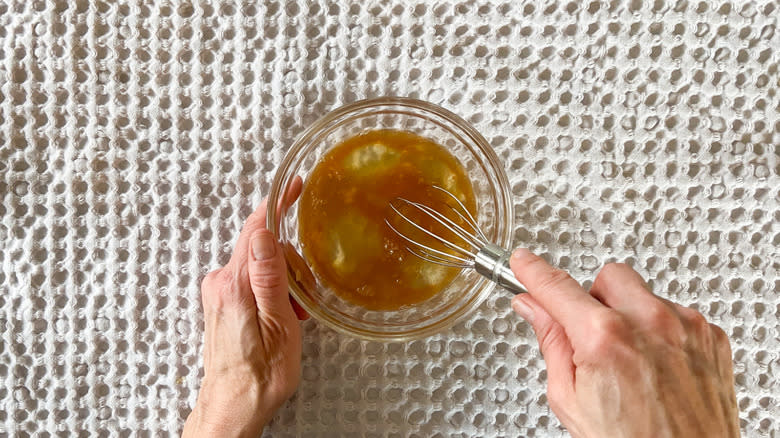
In a separate bowl, whisk together the whites and vanilla extract until slightly foamy.
Step 15: Mix Together The Dry Ingredients For The Cake
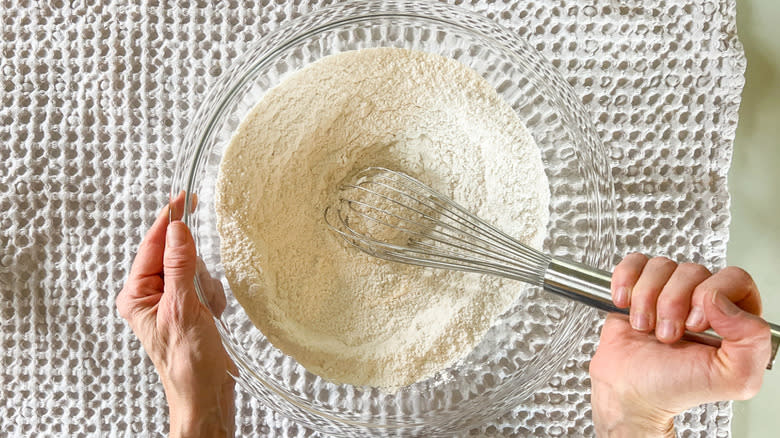
In a large mixing bowl, combine the flour, sugar, baking powder, and salt.
Step 16: Add The Butter And Milk To The Dry Ingredients
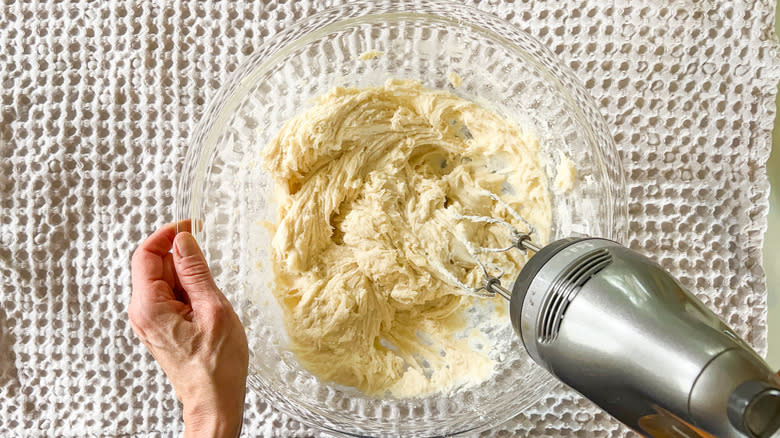
Add the butter and milk and use a hand mixer (or stand mixer) to incorporate on low speed, then increase the speed to high and beat for a minute longer.
Step 17: Add The Egg White Mixture In Two Batches
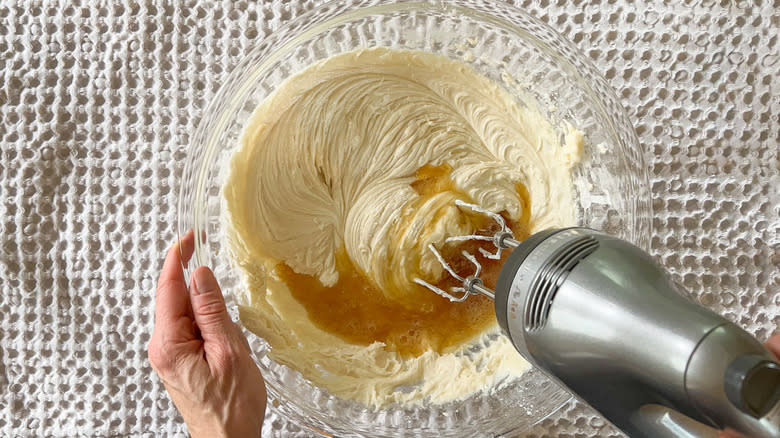
Add the egg white mixture in two batches, beating for about 30 seconds after each addition and scraping down the sides of the bowl.
Step 18: Mix In The White Chocolate
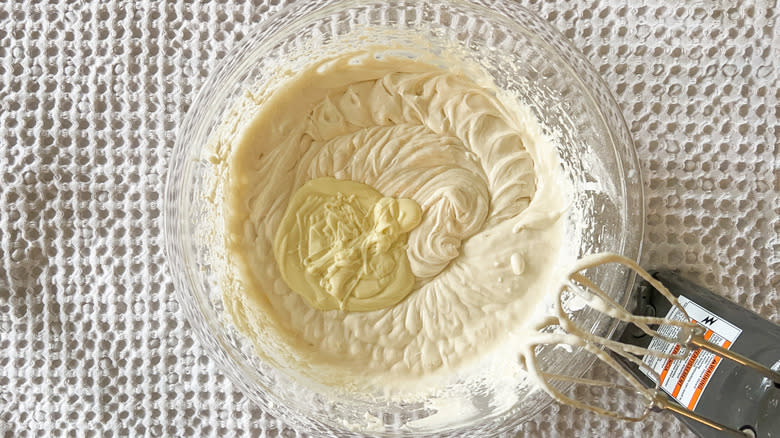
Add the melted and cooled white chocolate and beat until fully incorporated.
Step 19: Divide The Batter Between The Two Cake Pans
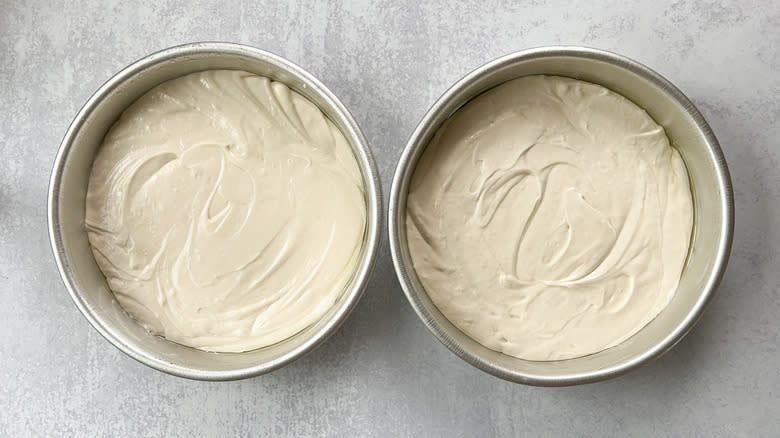
Divide the batter between the two cake pans and smooth the tops
Step 20: Bake The Cakes
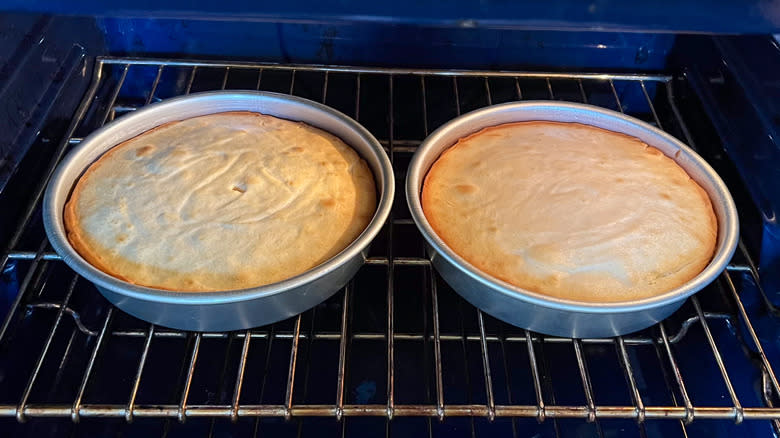
Bake the cakes for 25-30 minutes or until they're light golden brown and a toothpick inserted in the center comes out clean.
Step 21: Cool The Cakes
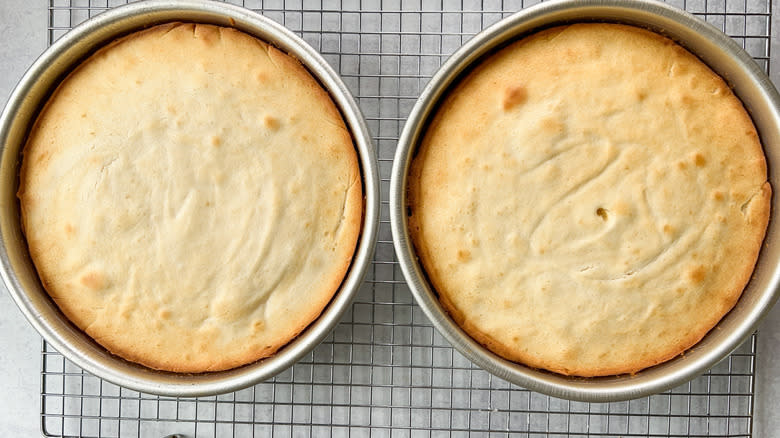
Cool the cakes completely in the pans on racks, then turn them out.
Step 22: Start The Lavender Simple Syrup
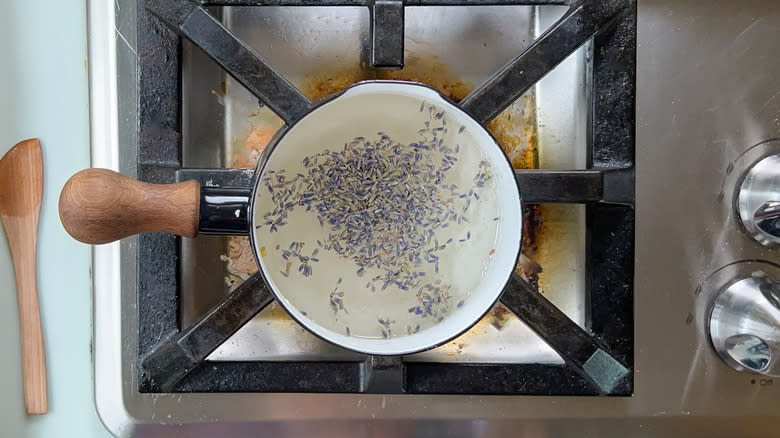
While the cakes are baking prepare the lavender simple syrup by combining the sugar, water, and dried lavender in a small saucepan.
Step 23: Steep The Lavender Simple Syrup
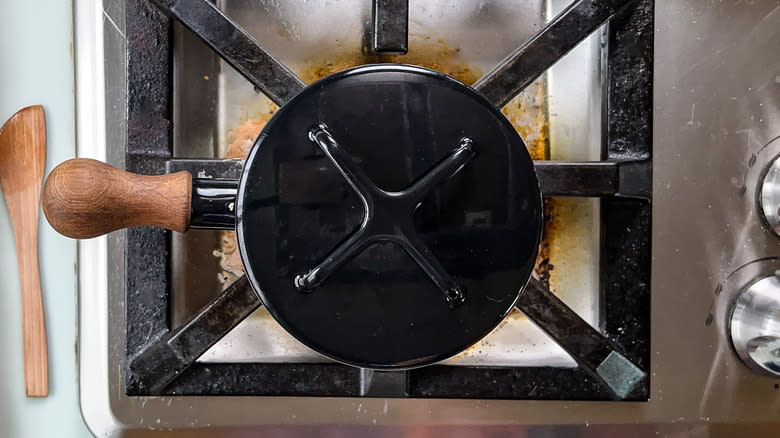
Bring the mixture to a boil, turn off the heat, and cover for 30 minutes to steep.
Step 24: Strain The Syrup
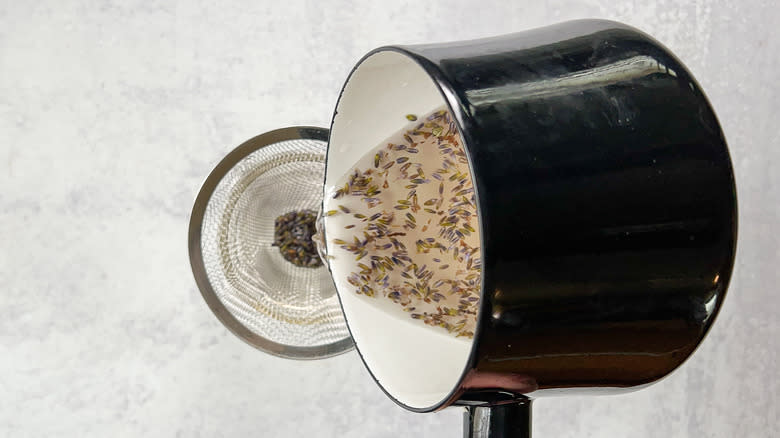
Strain the syrup into a jar or small bowl to cool and set aside.
Step 25: Start The Swiss Meringue Buttercream
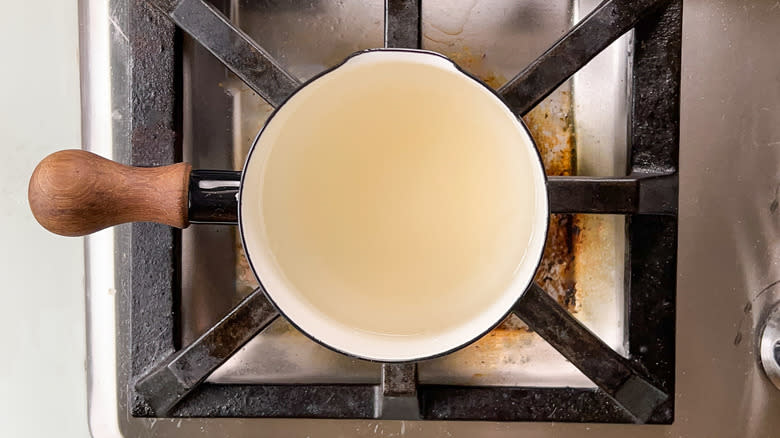
Start the buttercream by adding the water and ¾ cup of the sugar to a small saucepan.
Step 26: Cook The Sugar And Water Until Dissolved

Stir until the sugar is dissolved. Slowly heat the mixture while constantly stirring until it starts to bubble.
Step 27: Cook Until Large Bubbles Form
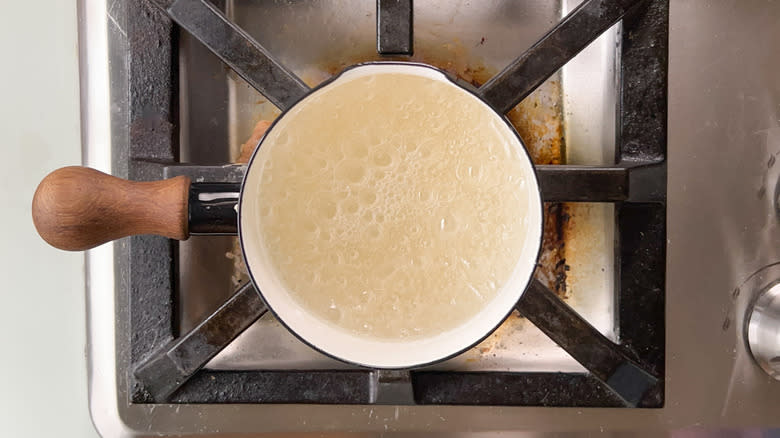
Continue to cook until large bubbles form.
Step 28: Beat The Egg Whites And Salt
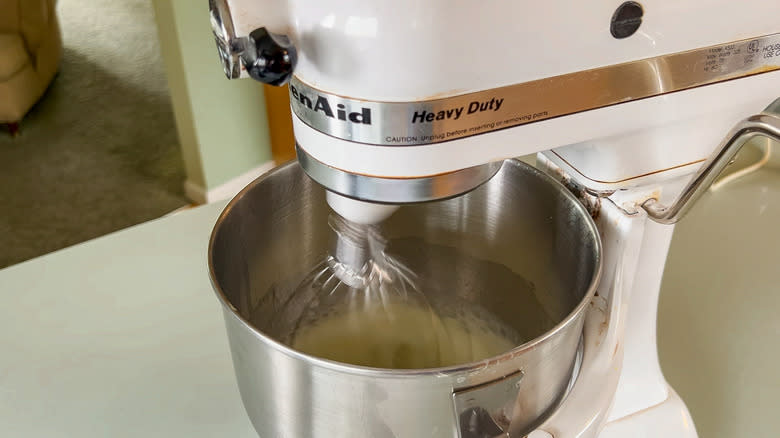
Meanwhile, in a stand mixer beat the egg whites and salt until foamy.
Step 29: Add The Cream Of Tartar
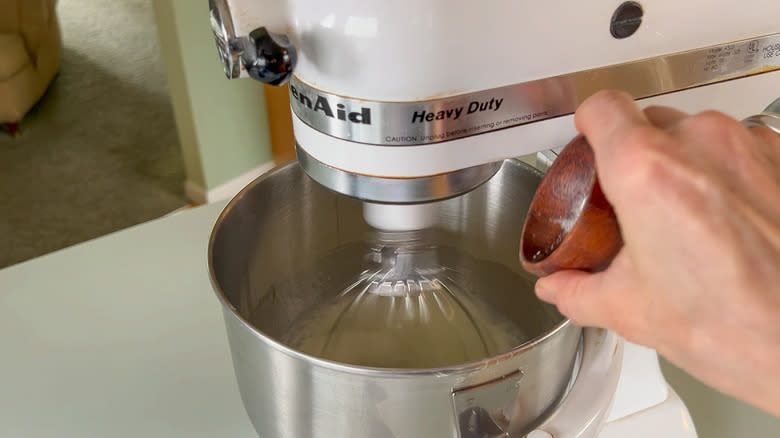
Add the cream of tartar and beat until soft peaks form.
Step 30: Add The Remaining Sugar
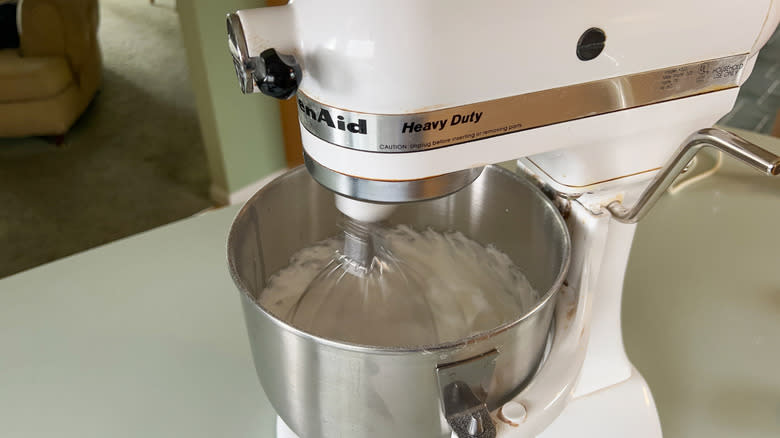
Gradually add the remaining ¼ cup sugar and beat until stiff peaks form.
Step 31: Drizzle In The Hot Sugar Syrup
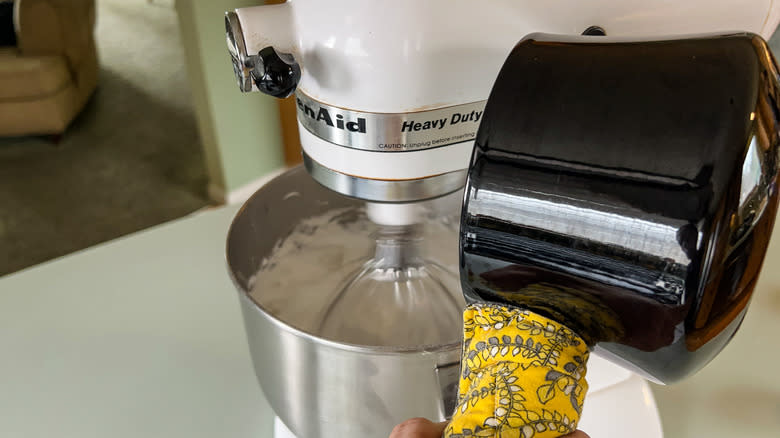
Slowly and carefully drizzle the cooked sugar mixture into the whipped egg whites with the mixer running constantly.
Step 32: Whip The Whites Until Cool
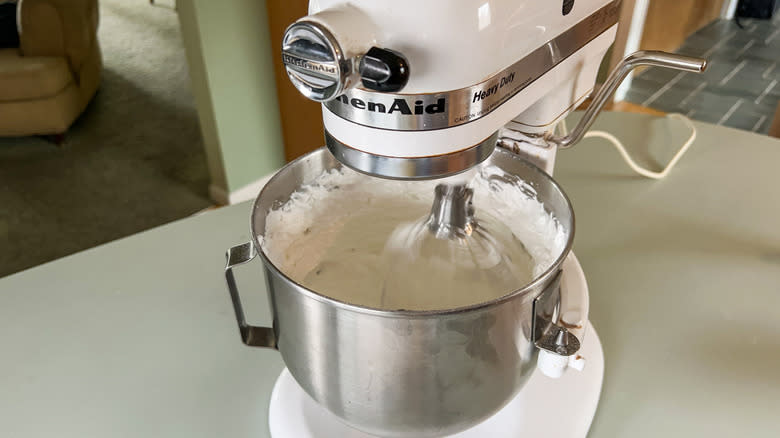
Beat at high speed until the mixture has cooled to room temperature (this may take up to 10 minutes).
Step 33: Add Extracts And Butter To Cooled Whites
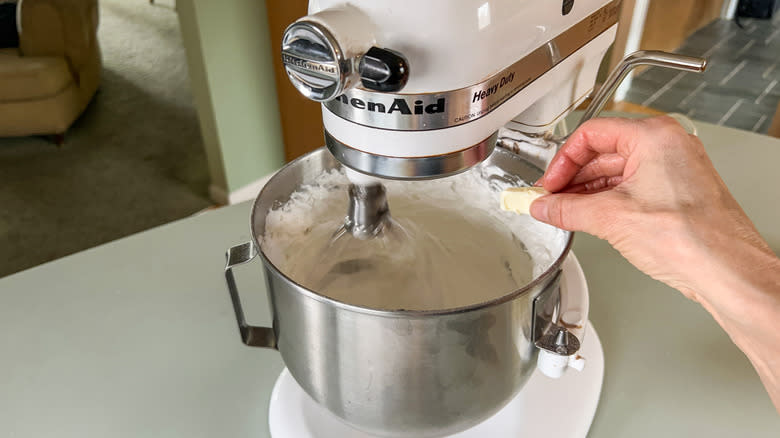
Turn the mixer down to medium speed and add the vanilla and lavender extracts. Add the butter one piece at a time until the mixture comes together and is silky, increasing the speed once the butter is incorporated.
Step 34: Start Assembling The Cake
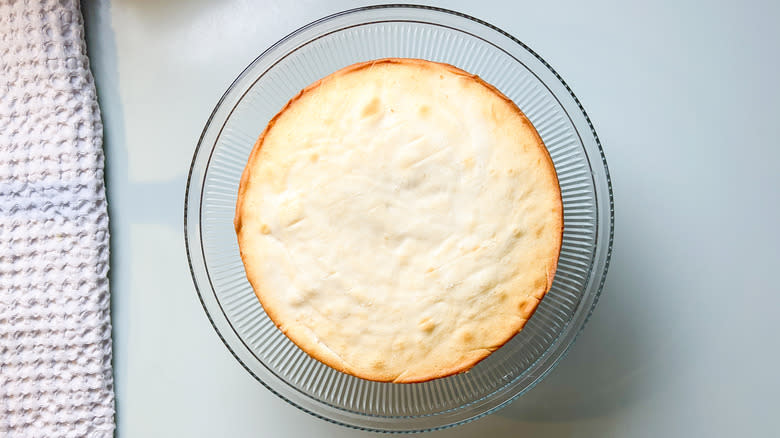
To assemble the cake, place one layer on a plate or platter.
Step 35: Brush The Cake With Lavender Simple Syrup
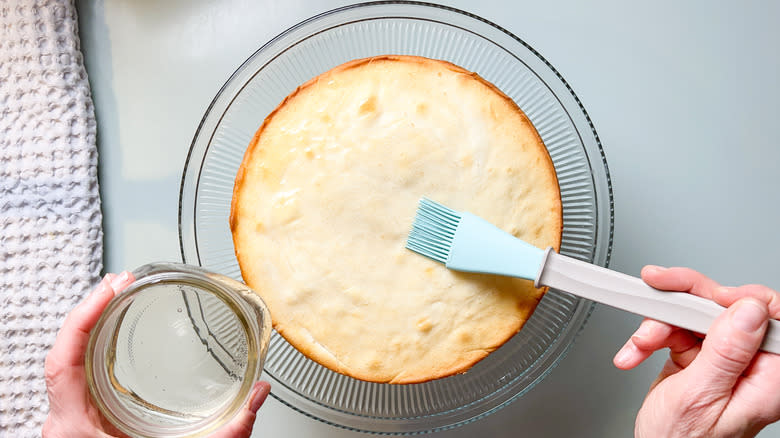
Brush on some of the lavender simple syrup to moisten the top.
Step 36: Pipe Buttercream Around The Edge Of The Cake
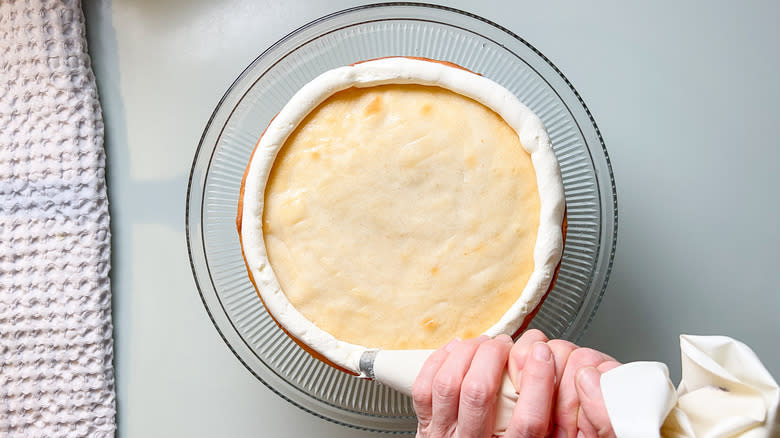
Use a pastry bag fitted with a large round tip to pipe a circle of buttercream around the edge of the cake top. This helps hold in the filling.
Step 37: Spread On The Lemon Curd
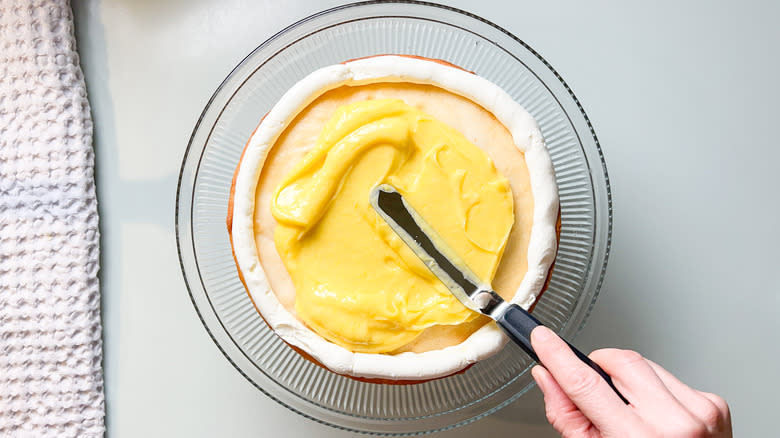
Spread the lemon curd evenly on the cake.
Step 38: Place The Top Layer On The Cake And Brush With The Syrup
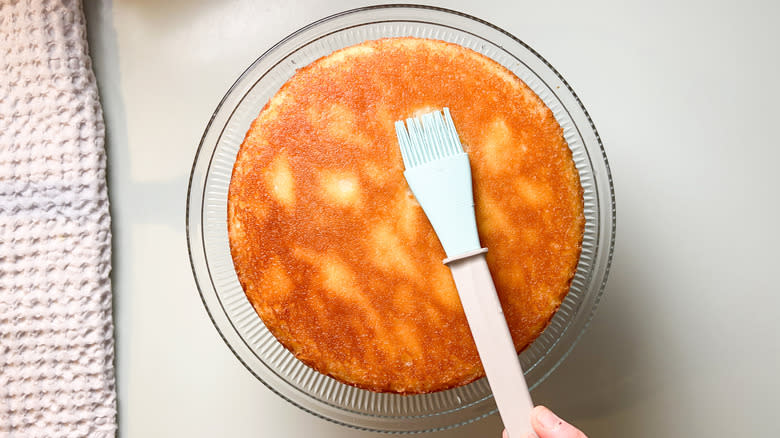
Brush the top of the second cake layer with the syrup and place it top-side down on the lemon curd. Brush the cake with the remaining syrup.
Step 39: Ice And Decorate The Cake With The Candied Lemon
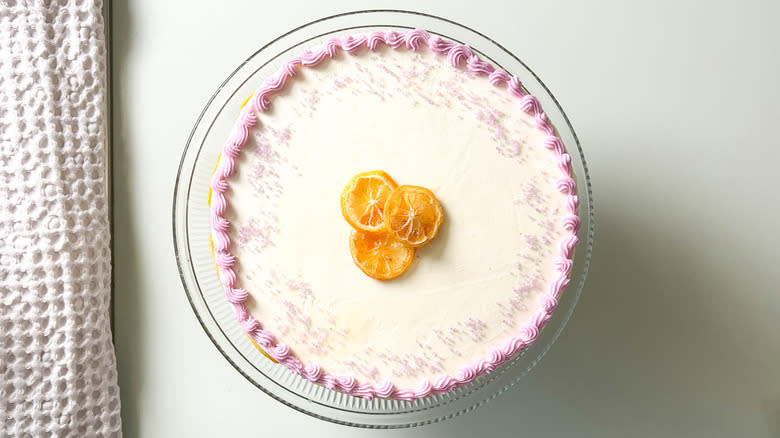
Ice the cake with the buttercream, adding decorative piping or food coloring, if desired. Press the candied lemon slices into the icing on the sides of the cake or use to garnish the top.
Step 40: Chill And Serve The Cake
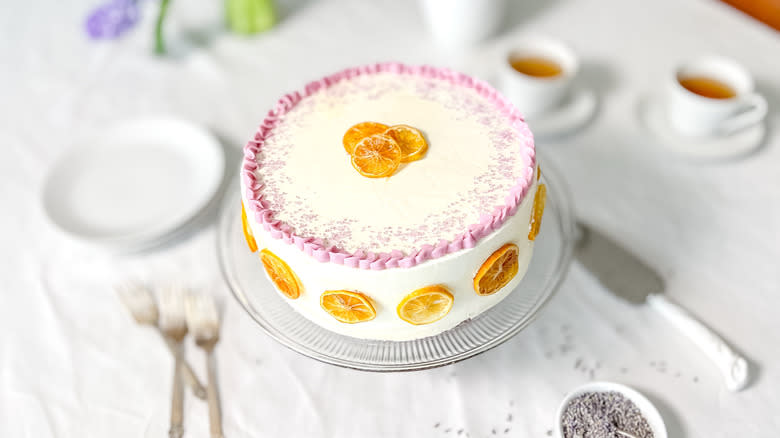
Chill the cake completely and then slice and serve. Cover and store the leftover cake in the refrigerator.
What Is Culinary Lavender?
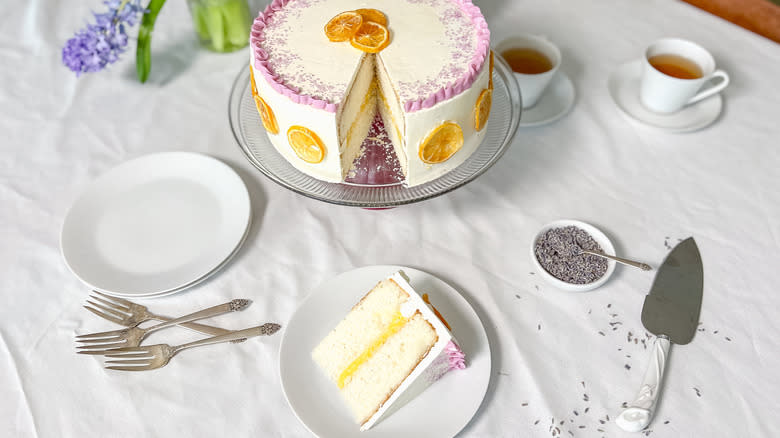
Culinary lavender is selected from specific varieties that have a more restrained aroma and flavor due to a lower essential oil content in the flowers. English lavender or "true lavender" is typically the type dried for culinary preparations. Culinary lavender is also grown without using pesticides or other harmful compounds that you don't want to ingest.
The key to cooking or baking with lavender is to use restraint. Too much lavender will lead to a soapy or perfumy quality in your food that can be off-putting. And never use lavender essential oil for flavoring. Pure culinary lavender extract, like the one used in this recipe, is specifically formulated for use in food and drink. Just remember that a very little goes a long way.
Culinary lavender can be found in the spice section of specialty grocers, spice shops, or online. If you happen to grow your own lavender, find out what variety it is and experiment with drying the buds for your own culinary use.
What Are Some Tips And Tricks For Success Making The Swiss Meringue Buttercream?
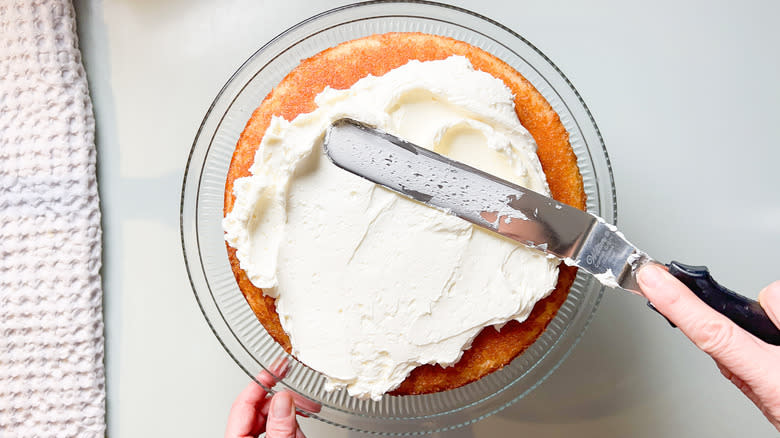
When made properly, Swiss meringue buttercream is the ultimate silky-smooth, rich, yet not overly sweet buttercream you can make. It holds its shape beautifully and pairs with any number of flavorings, such as the vanilla and lavender used in this recipe. To make Swiss meringue you cook whipped egg whites by slowly streaming in boiled sugar syrup, resulting in a super-stable yet light meringue. Adding butter creates the buttercream.
The process can be intimidating the first time you try it, but Kinnaird says that the key to success with this recipe is to have all the ingredients at the proper temperature. To get the most volume out of the egg whites, they must be at room temperature. Make sure that the sugar syrup thickens and creates large bubbles in the pan before you drizzle it into the whites. This will ensure that all the sugar granules have dissolved properly into the water. Last, it is crucial that your whites have come to room temperature before you add the butter. And be sure the butter is cold, as melted butter will create a broken buttercream.
Kinnaird also warns that the beaten whites will lose a lot of volume once you start to add the butter and the mixture may look like it will break. But suddenly everything will come together and you'll have a lovely silky buttercream that is ready to use!
Bright And Sunny Lemon Lavender Cake Recipe
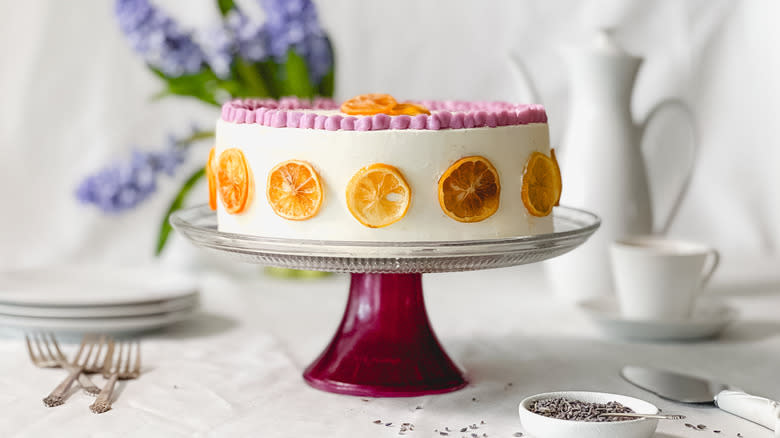
Prep Time: 10h 30mCook Time: 1h 15mYield: 12 SlicesIngredients
:::For the candied lemon slices:::
½ cup granulated sugar
½ cup water
1 large or 2 small lemons, very thinly sliced
:::For the lemon curd:::
4 egg yolks
½ cup granulated sugar
⅓ cup fresh lemon juice
4 tablespoons unsalted butter
⅛ teaspoon salt
1 tablespoon grated lemon zest
:::For the cake layers:::
6 ounces chopped white chocolate
4 large egg whites, room temperature
1 teaspoon vanilla extract
3 cups sifted cake flour
1 cup granulated sugar
1 tablespoon plus 1 teaspoon baking powder
1 teaspoon salt
1 cup whole milk, room temperature
8 tablespoons unsalted butter, softened
:::For the lavender simple syrup:::
½ cup granulated sugar
½ cup water
1 tablespoon dried culinary lavender
:::For the Swiss meringue buttercream:::
1 cup granulated sugar
¼ cup water
5 large egg whites, room temperature
½ teaspoon salt
½ teaspoon cream of tartar
2 cups unsalted butter, cut into small cubes
2 teaspoons vanilla extract
¼ teaspoon lavender extract
Directions
To make the candied lemon, combine the sugar, water, and lemon slices in a wide saucepan and bring to a boil.
Reduce the heat to medium-low and simmer the lemon slices for 20 minutes or until the peels are translucent.
Transfer the slices to a rack to cool and allow to dry for at least 8 and up to 24 hours.
For the lemon curd, whisk together the yolks and sugar until pale yellow in a medium bowl.
In a medium saucepan, combine the lemon juice, butter, salt, and zest, heating gently until the butter has melted.
Temper the egg mixture by slowly drizzling in the warm butter mixture, whisking constantly.
Transfer the curd base back to the saucepan and cook over medium-low heat, stirring constantly with a wooden spoon until thickened but not boiling.
Strain the curd into a medium glass bowl.
Cover the curd with plastic on the surface to prevent a skin from forming and place the bowl in the refrigerator to chill completely while baking the cakes (about 1 hour).
Preheat the oven to 350 F.
Grease and line the bottoms of two 9-inch round cake pans with parchment paper.
Create a double boiler by bringing an inch of water to a simmer in a saucepan.
Turn off the heat and place the white chocolate in a heat-proof bowl over the pan, stirring frequently until the chocolate is melted. Remove the bowl and set aside.
In a separate bowl, whisk together the whites and vanilla extract until slightly foamy.
In a large mixing bowl, combine the flour, sugar, baking powder, and salt.
Add the butter and milk and use a hand mixer (or stand mixer) to incorporate on low speed, then increase the speed to high and beat for a minute longer.
Add the egg white mixture in two batches, beating for about 30 seconds after each addition and scraping down the sides of the bowl.
Add the melted and cooled white chocolate and beat until fully incorporated.
Divide the batter between the two cake pans and smooth the tops
Bake the cakes for 25-30 minutes or until they're light golden brown and a toothpick inserted in the center comes out clean.
Cool the cakes completely in the pans on racks, then turn them out.
While the cakes are baking prepare the lavender simple syrup by combining the sugar, water, and dried lavender in a small saucepan.
Bring the mixture to a boil, turn off the heat, and cover for 30 minutes to steep.
Strain the syrup into a jar or small bowl to cool and set aside.
Start the buttercream by adding the water and ¾ cup of the sugar to a small saucepan.
Stir until the sugar is dissolved. Slowly heat the mixture while constantly stirring until it starts to bubble.
Continue to cook until large bubbles form.
Meanwhile, in a stand mixer beat the egg whites and salt until foamy.
Add the cream of tartar and beat until soft peaks form.
Gradually add the remaining ¼ cup sugar and beat until stiff peaks form.
Slowly and carefully drizzle the cooked sugar mixture into the whipped egg whites with the mixer running constantly.
Beat at high speed until the mixture has cooled to room temperature (this may take up to 10 minutes).
Turn the mixer down to medium speed and add the vanilla and lavender extracts. Add the butter one piece at a time until the mixture comes together and is silky, increasing the speed once the butter is incorporated.
To assemble the cake, place one layer on a plate or platter.
Brush on some of the simple syrup to moisten the top.
Use a pastry bag fitted with a large round tip to pipe a circle of buttercream around the edge of the cake top. This helps hold in the filling.
Spread the lemon curd evenly on the cake.
Brush the top of the second cake layer with the syrup and place it top-side down on the lemon curd.
Brush the cake with the remaining syrup.
Ice the cake with the buttercream, adding decorative piping or food coloring, if desired. Press the candied lemon slices into the icing on the sides of the cake or use to garnish the top.
Chill the cake completely and then slice and serve. Cover and store the leftover cake in the refrigerator.
Read the original article on Tasting Table

